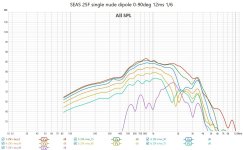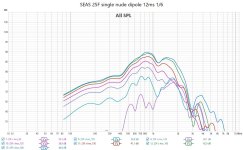That’s what the patent looks to indicate to my eyes. It appears to be a multi-faceted Linaeum type tweeter. Which seem to be generically known as ‘Rubanoid’ tweeters. Whatever a Rubanoid is.
And those look like they’re some seriously expensive speakers. Caveat Emptor.I have heard that Bays Audio speaker you mentioned before and I thought it sounded like crap. Don't copy it!
Ruban is French for ribbon, so you could call it Ribbonoid.That’s what the patent looks to indicate to my eyes. It appears to be a multi-faceted Linaeum type tweeter. Which seem to be generically known as ‘Rubanoid’ tweeters. Whatever a Rubanoid is.
The patent sketches don't look anything like the photos to me, more of a tapered tube than a quad of ribbonoids aligned 90° apart. The woofers are quite different too, with the spiders midpoint in the basket and a good portion of the VC exposed. I think the last bit would be essential to good HF response
ripblade,A driver with a small magnet and cast basket with narrow spokes would be better suited but also be a strange, rare beast. Even if one could be found, dispersion would be limited to midrange along the horizontal axis dictating the need for a tweeter. Old school is to use a reflector with a normally configured driver. My own experiments along these lines lead me to conclude that vertical dispersion is just as desirable in an omni, at least for a stage height that matches the width and depth.
I’m curious about the details of that Nerf football reflector you’re cleverly using. I can see how the ovoid shape could be advantageous for dispersing the sound horizontally, and vertically throughout the listening room. Since Nerf footballs are, however, made of a foam-rubber like material doesn’t that greatly reduce its effectiveness as a sound reflector? it looks in the photos that you may have coated the surface of one side with some substance, possibly to harden that surface?
No coating, the two sides are different colours but the same texture. The foam is closed cell and the surface ia actually quite smooth, I suppose for cleaning purposes as these are children's toys and need to be washable. The foam was a bit of a concern initially, but now I think the soft, low density is an advantage as it prevents the possibility of the reflector developing sympathetic resonances (ringing) that could colour the sound as the walls of a horn might do. Overall, I think it's pretty benign in that aspect. I just wish it looked better lol.Since Nerf footballs are, however, made of a foam-rubber like material doesn’t that greatly reduce its effectiveness as a sound reflector? it looks in the photos that you may have coated the surface of one side with some substance, possibly to harden that surface?
Is it safe to assume that you don’t find the football’s foam material to substantially absorb, or otherwise roll-off the treble of the reflected energy to an unsatisfactory degree? I have been presuming that a hard surfaced reflector would be required.
A bit late in the game, plus I did not read all the posts, but a first step toward improvement with a horizontally mounted driver would be to rebuild the driver in such a way the magnet is inside the cone instead of outside. Plus: frame inside. The magnet assembly then no longer obstructs radiation. This is the technique Bloomline, as shown by Wout31 in his first post in this thread, applies with rebuilt KEF Uni Q drivers. I vaguely recall Steve Deckert doing something similar. Whether it really works I do no know: never seen proper measurements of such set ups.
It's not like acoustic foam, porous and all that, but I suppose a polished metal reflector would be more efficient.Is it safe to assume that you don’t find the football’s foam material to substantially absorb, or otherwise roll-off the treble of the reflected energy to an unsatisfactory degree? I have been presuming that a hard surfaced reflector would be required.
Here is Deckert’s omni speaker which I believe you are referring to.A bit late in the game, plus I did not read all the posts, but a first step toward improvement with a horizontally mounted driver would be to rebuild the driver in such a way the magnet is inside the cone instead of outside. Plus: frame inside. The magnet assembly then no longer obstructs radiation. This is the technique Bloomline, as shown by Wout31 in his first post in this thread, applies with rebuilt KEF Uni Q drivers. I vaguely recall Steve Deckert doing something similar. Whether it really works I do no know: never seen proper measurements of such set ups.
https://www.decware.com/newsite/ERR.html
One other question if you’ll permit. You previously alluded to trying other objects as the reflector. What were the reasons, subjective or objective, for why you settled on the football?It's not like acoustic foam, porous and all that, but I suppose a polished metal reflector would be more efficient.
Thanks Chris,
The site in your link was unknown to me, but it contains a wealth of info and experiments. Very, very nice.
The site in your link was unknown to me, but it contains a wealth of info and experiments. Very, very nice.
Interesting, havent tried this.
Spherical- Ping Pong Ball Tweeter
Radio Electronics 1958/06
https://www.worldradiohistory.com/hd2/IDX-Consumer/Archive-Radio-Electronics-IDX/IDX/50s/1958/Radio-Electronics-1958-06-OCR-Page-0091.pdf#search="ping pong ball tweeter"
---
Ikonoklast
https://www.dagogo.com/konoklast-model-3-ho-floorstanding-speaker-review/
https://web.archive.org/web/2013032...goire.com/hifi-stereo-ikonoklast-tweeters.htm
Spherical- Ping Pong Ball Tweeter
Radio Electronics 1958/06
https://www.worldradiohistory.com/hd2/IDX-Consumer/Archive-Radio-Electronics-IDX/IDX/50s/1958/Radio-Electronics-1958-06-OCR-Page-0091.pdf#search="ping pong ball tweeter"
---
Ikonoklast
https://www.dagogo.com/konoklast-model-3-ho-floorstanding-speaker-review/
https://web.archive.org/web/2013032...goire.com/hifi-stereo-ikonoklast-tweeters.htm
Last edited:
I have listened to both the Bayz speakers currently in production. The larger one in AXPONA for brief account of time and the smaller one in a store for nearly 2 hours. The imaging is 3d and sound stage huge, I think that is common among Omni drivers like MBL. But what really strikes me was the bass is incredible. Fast, tight, super well defined. Anyone know more about how that funny double fat tube works? Looks too short to be transmission line. Just a tube shaped reflex? There's a port at the back for each half
About two months ago during a survey of some old 15" drivers for my reflector-point-source experiment (see Fullrange Photo Gallery), I was surprised to hear what @dcgold @CharlieLaub charts showed, for the Peavey Scorpion! Whereas the front dustcap attenuated HF above ~4khz, the curvilinear cone (see picture) actually radiated to the rear sides at least to ~9khz. I had a pair of them isobaric face-to-face over stacked cubes -- the bass was good, and so was the treble after topping with a wash-basin/bowl 360° "horn" (to be improved; a bit of "treatment" to the basket is also planned).
However, I suspect there was uncancelled HF bleed-through from the bottm driver as well.
Scorpion stealth bomber

However, I suspect there was uncancelled HF bleed-through from the bottm driver as well.
Scorpion stealth bomber
Last edited:
I have measured many drivers' rearside, but only few are saved. I have been interested in dipoles, so these are "nude" with no or minimal frame. Dipole has very smooth of-axis radiation below axial "dip". The baffle size of a monopole driver modifies radiation from lower freq than the dipole. Monopole has flat response below baffle step effect.
4" Audax poly cone has more interferences from the "motor" than the 8". Rearside response is staggered above 2kHz
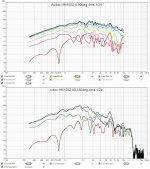
8" SEAS paper cone rearside shows smooth response only up to 1kHz
4" Audax poly cone has more interferences from the "motor" than the 8". Rearside response is staggered above 2kHz

8" SEAS paper cone rearside shows smooth response only up to 1kHz
Attachments
Perhaps ideally only to 400Hz, above that directivity and irregularities increase rapidly. Max 1000Hz I'd say. The smaller the box/pole is, the better.
Actually it doesn't matter much if magnet is up or down in this band.
With horizontally positioned driver, we are listening at 80-110deg off-axis!
Here horizontal directivity of a small sealed box 6" coaxial (motor in the box) measured outdoors. LR4 around 2kHz. 90deg smooth to 600Hz
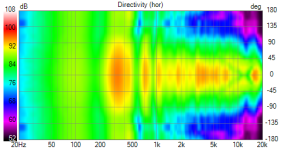
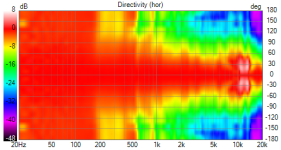
Actually it doesn't matter much if magnet is up or down in this band.
With horizontally positioned driver, we are listening at 80-110deg off-axis!
Here horizontal directivity of a small sealed box 6" coaxial (motor in the box) measured outdoors. LR4 around 2kHz. 90deg smooth to 600Hz


- Home
- Loudspeakers
- Planars & Exotics
- Inverted mounted driver polar-response
